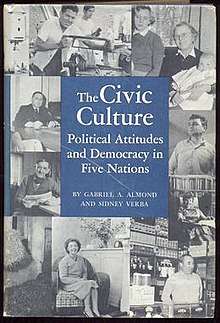The Civic Culture
 Cover of the 1963 edition | |
| Author |
Gabriel Almond, Sidney Verba |
|---|---|
| Publisher | Sage Publications, Inc |
Published in English | December 1963 |
| Media type | |
| Pages | 574 ppg (1963 release) |
| ISBN |
0691075034 (1963 release) ISBN 0803935587 (1989 release) |
The Civic Culture or The Civic Culture: Political Attitudes and Democracy in Five Nations is a 1963 political science book by Gabriel Almond and Sidney Verba.[1] The book is credited with popularizing the political culture sub-field and is considered to be the first systematic study in this field.[2][3]
Synopsis
In the text Almond and Verba examine the democratic systems in five countries, the United States, Germany, Mexico, Italy, and the United Kingdom. They interviewed about a thousand individuals in each country on their views of government and political life. As they define it, the "civic culture" (singular) is "based on communication and persuasion, a culture of consensus and diversity, a culture that [permits] change but [moderates] it" (Almond and Verba 1963, 8). They identify three political structures: participant, subject, and parochial.[4] They consider political culture to be the element that connects individual attitudes with the overall political system structure.[5]
Almond and Verba considered the Italian emphasis on the family as the driving main force for society as "amoral" (in the words of Edward Banfield (The Moral Basis of a Backward Society, 1958), or "exclusive", and believed that such a culture would impede the culture's potential for developing a "sense of community and civic culture," which they saw as a necessary background for "effective democracy".[6]
Reception and criticisms
Seymour Lipset wrote in The Democratic Century that Almond and Verba "did argue persuasively that the extent of civic culture could be predicted by structural and historical factors" but that there was also "strong evidence that some aspects of the civic culture were powerfully associated with education levels, across national borders".[7]
The Civic Culture was criticized for having an "Anglo-American bias", with the authors stating that only the United Kingdom and the United States possessed the capability for long term democratic stabilization.[8] Critics also expressed skepticism over the accuracy of depicting a culture based upon individual interviews and that the approach was "ethnocentric and more prescriptive than objective and empirical".[9]
References
- ↑ Baker, Kendall (181). Germany Transformed: Political Culture and the New Politics. Harvard University Press. ISBN 0674353153.
- ↑ Wilson, Catherine (2008). The Politics of Latino Faith. NYU Press. pp. 17–18. ISBN 0814794130.
- ↑ Caramani, Daniele (2008). Comparative Politics. Oxford University Press. p. 420. ISBN 0199298416.
- ↑ Crothers, Lane (2000). Culture and Politics: A Reader. Palgrave Macmillan. p. 51. ISBN 0312233000.
- ↑ Franklin, Daniel (2006). Politics and Film: The Political Culture of Film in the United States. Rowman & Littlefield Publishers. p. 4. ISBN 0742538095.
- ↑ Kawata, Junichi (2006). Comparing Political Corruption And Clientelism. Ashgate Pub Co. p. 145. ISBN 0754643565.
- ↑ Lipset, Seymour (2004). The Democratic Culture. University of Oklahoma Press. p. 201. ISBN 0806136189.
- ↑ Axleford, Barry (1997). Politics: An Introduction. Routledge. pp. 58–63. ISBN 0415110750.
- ↑ Barrington, Lowell (2009). Comparative Politics: Structures and Choices. Wadsworth Publishing. p. 108. ISBN 0618493190.